

Thermoplastics and thermosets are widely used in injection molding – They are two separate classes of polymers with distinct properties and characteristics. Thus, it is imperative to choose the right category of polymer in order to achieve the expected results for your project.
Thermosets are a group of polymers that strengthen when heated, but cannot be remolded or heated after the initial forming whereas thermoplastics can be reheated, remolded, and cooled as necessary without causing any chemical changes. This is because thermoplastic materials have low melting points while thermoset plastics can withstand higher temperatures without losing their structural integrity. Now that we understand the primary difference between the two, let’s get to know these 2 polymers further.
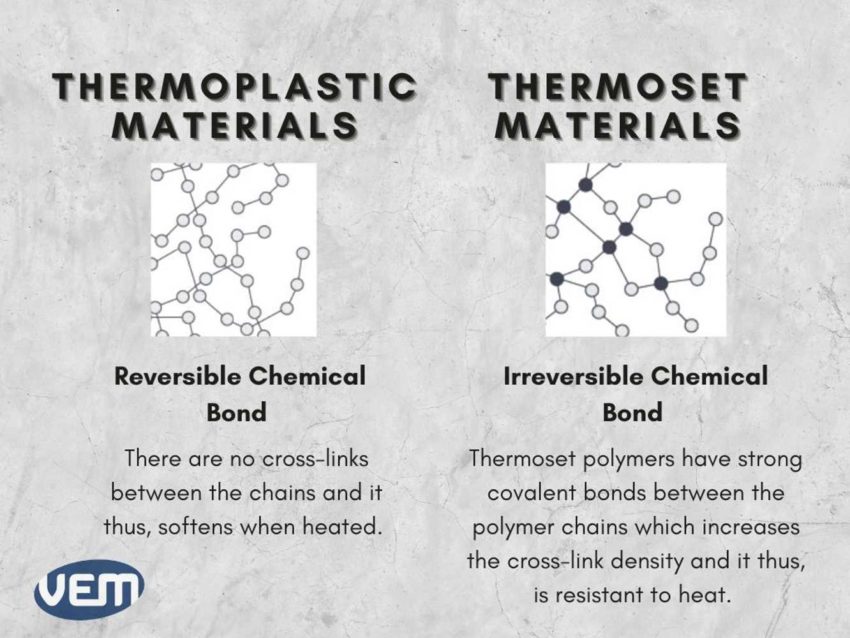
Thermoplastic polymers are extremely versatile and are known for their recyclability. They can be applied to various applications such as plastic containers and bottles for consumer goods, life-saving medical devices, and complex aerospace components.
Thermoplastic polymers are formed when monomers link into chains or branches. There are no cross-links between the chains and it thus softens when heated. Some examples of thermoplastic polymers include polyethylene, PVC, and nylon.
The primary characteristic that defines any plastic as a thermoplastic is that it softens when heated and becomes more fluid as more heat is administered. In this case, no chemical bonding takes place which is why the curing process is 100% reversible. This particular characteristic enables the thermoplastics to be remolded and recycled without compromising the physical properties of the resin.
There are a variety of thermoplastic resins that offer various performance benefits, but they typically offer high strength, incredible shrink resistance, and great flexibility. Thermoplastics also exhibit certain disadvantages such as susceptibility to creep and poor resistance to organic and polar solvents.
Thermoplastic resins soften when exposed to heat and they further become fluid when additional heat is applied. There is no chemical bonding that takes place, which is why the curing process of thermoplastics is completely reversible. Thus, this chemical characteristic enables the remodeling and recycling of thermoplastics without negatively affecting the physical properties of the material.
There are various types of thermoplastic materials. Some of the most common thermoplastic materials that are used for manufacturing are listed below:
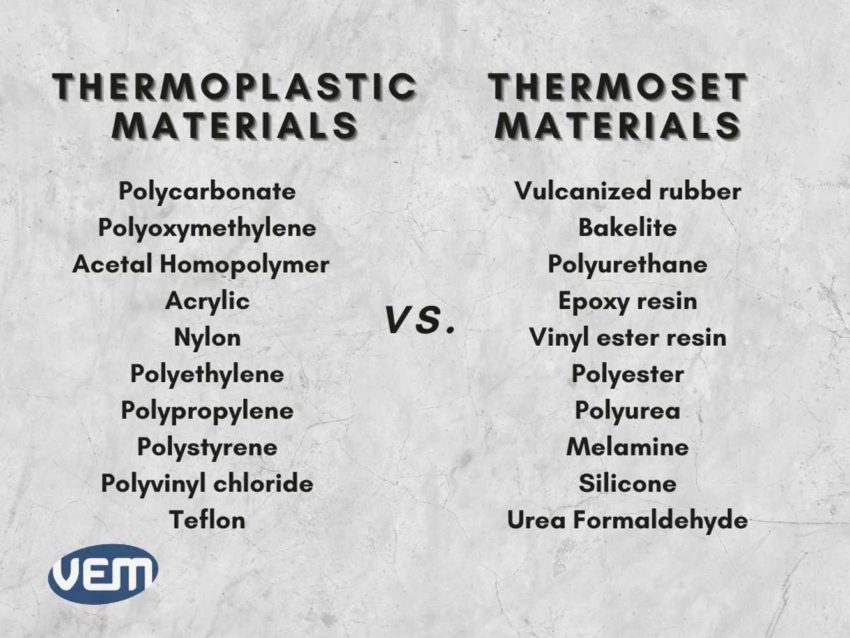
All the above thermoplastics can be melted and reshaped into different forms thus, they can be recycled easily. For example, a foam cup can be heated to re-melt to transform it into a dish.
Today thermoplastics are applied to various industries ranging from medical equipment, and electrical components to automotive covers. In addition, thermoplastics are also used in packaging, storage materials, and consumer goods. Let’s understand the predominant applications of thermoplastic polymers in various industries:
Thermoplastics are widely used for automotive industry projects. Some examples are listed below:
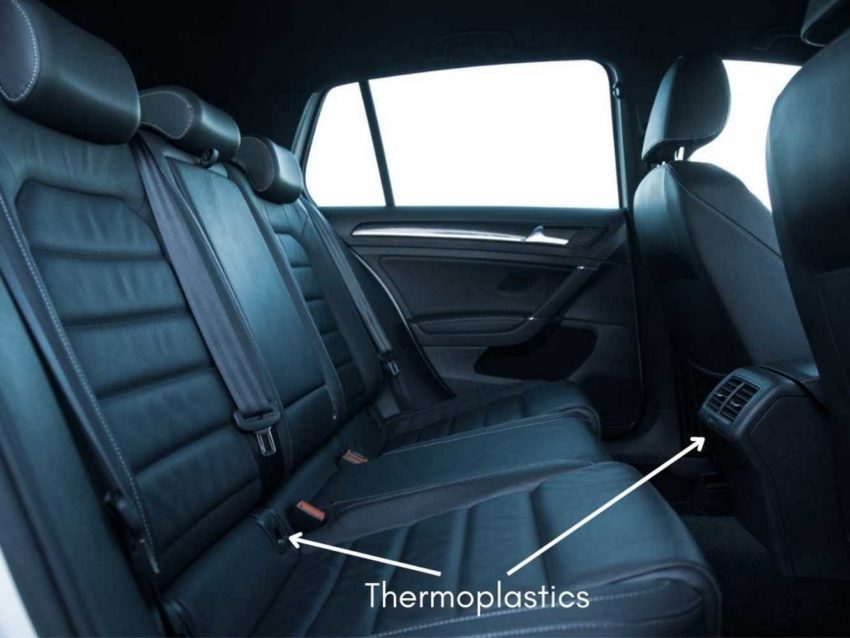
Thermoplastic polymers such as polystyrene, polypropylene, and polyvinyl chloride have good thermal resistance and are thus widely used for manufacturing electrical insulation products.
Thermoplastic polymers have also been widely employed in mechanical applications due to their strength, durability, and resistance to abrasion. Nylon demonstrates all these properties which is why it is used to manufacture gear wheels, power tool casings, machine screws and other mechanical parts.
Thermoplastic elastomers exhibit a high degree of purity, recyclability, excellent elasticity, and ease of sterilization which is why they are apt for manufacturing medical equipment such as syringes, medical tubing, glucose measuring devices, disposable surgical gowns, etc.
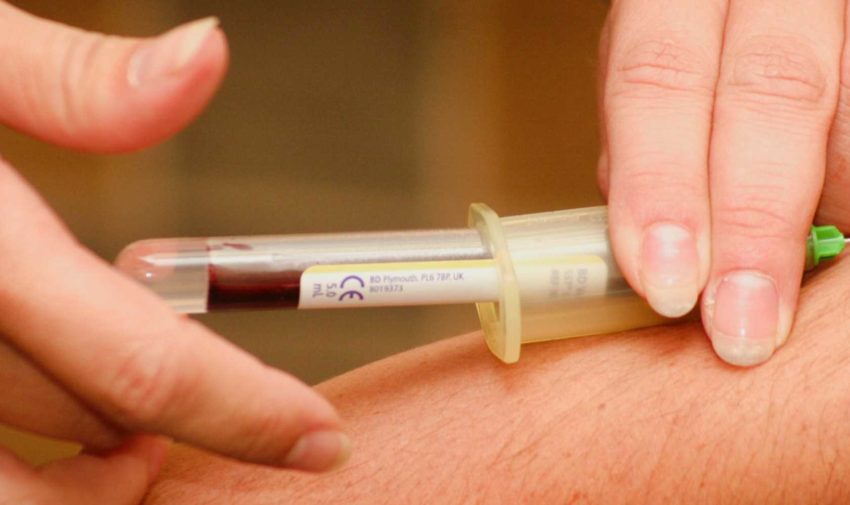
Nylon is known for its capacity to stretch which is why it is used to manufacture parachutes, conveyor belts, seat belts, tarpaulins, etc.
Thermoplastic polymers such as polypropylene sheets and Polyamide 6, are lightweight, safe and hygienic which is why they are used to manufacture storage boxes and in medical packaging.
Today, plastics are one of the most common materials used in the manufacturing industry. There are various projects that require plastic resins to withstand rigorous physical and chemical elements such as excessive heat and corrosion. In such cases, the popular choice of plastics is thermosets.
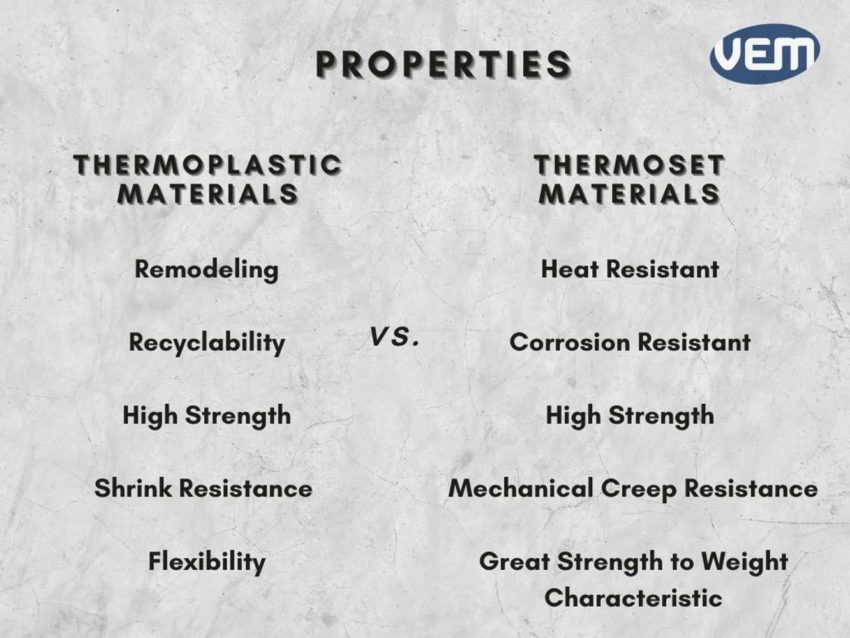
Thermosets are quite unique and they differ significantly from thermoplastics. After the initial heat treatment, thermoset polymers do not get affected by additional heat exposure thus, thermoset polymers exhibit incredible resistance to heat, corrosion, and mechanical creep. These properties make them suitable for projects that require tight tolerances and excellent strength-to-weight characteristics while being exposed to elevated temperatures.
Thermoset polymers form an irreversible bond due to cross-linking during the curing process. The cross-linking process does not allow the product to remelt when heat is applied which makes them ideal for high-heat applications.
Thermoset polymers are manufactured from various types of materials. They serve key roles and applications in the plastics fabrication industry. Some of the most common thermoset materials that are used for manufacturing are listed below:
Thermoset polymers are capable of meeting the specifications of a wide range of production materials at a very low cost. Thermosets provide an alternative approach to when complex and geometric shapes cannot be achieved through metal fabrication.
In addition, thermoset plastics offer an enhanced high-performance combination of thermal stability, chemical resistance, and structural integrity thus, they can be applied to a wide range of industries such as automotive, appliance, electrical, lighting, and energy markets. Let’s understand the predominant applications of thermoset polymers in various industries:
Glass-reinforced polyester thermosets are widely used in the automotive industry to manufacture body panels, seats, and interior components. In addition, carbon fiber composites are used to manufacture under-the-hood components.
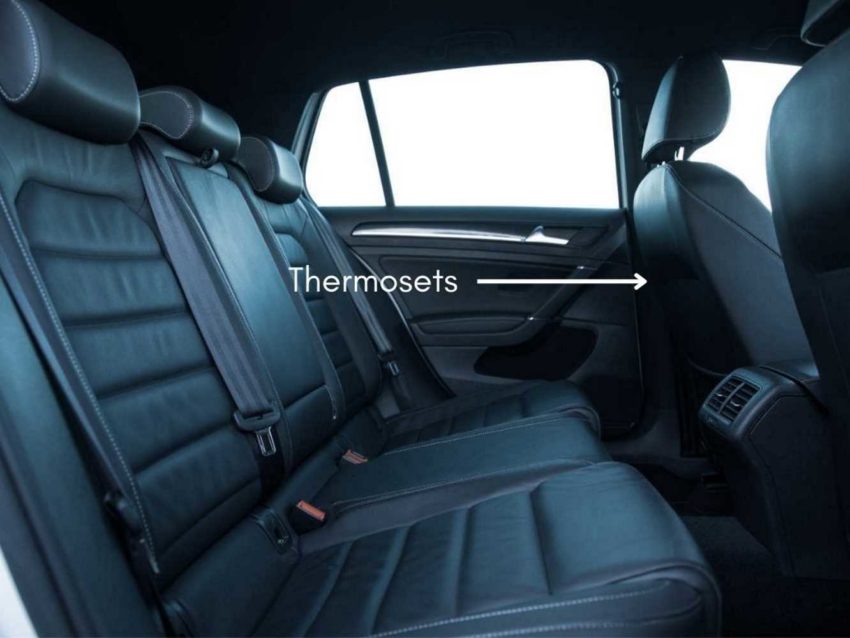
Thermosets such as epoxy or carbon fiber composites are often used to manufacture sports equipment. Some examples include tennis racquets, golf clubs, and ski equipment.

Thermosets are also widely applied in both commercial and residential construction industries. Thermosets such as polyester and epoxy thermoset are readily used in kitchens and bathrooms. They span a wide range of applications such as sinks, shower stalls, doors, wall panels, window frames, and even swimming pools.
Just like the commercial and residential construction industry, polyester and epoxy thermoset composites can be applied to manufacture various kitchen appliances such as dishwashers, refrigerators, ovens and dryers.
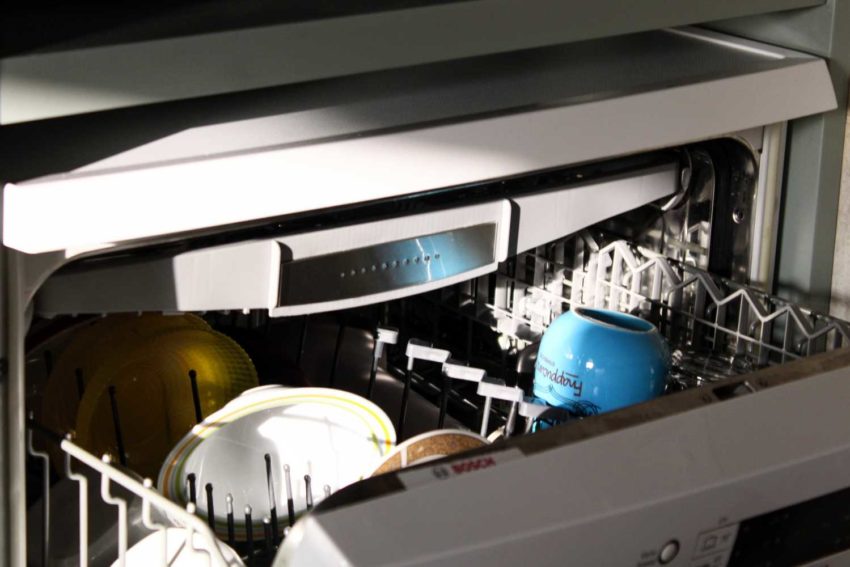
In the electrical industry, thermosets of phenolic-matrix and melamine composites are commonly used to manufacture circuit boards, gears, and insulators. In addition, silicone-based composites are used to manufacture insulation or circuit boards that require high heat resistance.
Some of the most common examples of thermoplastic polymers are polyester, polypropylene, Teflon, polystyrene, and acrylic. They are primarily any type of plastic that melts into a soft, pliable form at a specific temperature and then solidifies upon cooling. Due to this property, these materials can be re-melted and recycled.
An example of a thermoplastic would be nylon. Nylon is known for its high strength, flexibility and elasticity which is why it is often used to manufacture seat belts and conveyor belts.
Some of the most common examples of thermoset polymers are epoxy, polyurethane, phenolic, and silicone. Thermoset plastics are stored in liquid form and once solidified, they cannot be turned back into their liquid form. Different types of thermoset plastics offer different advantages. For example, epoxy composites are tough and chemical resistant while phenolic composites are flame resistant.
An example of a thermoset plastic would be epoxy resins that are used to manufacture sports equipment and kitchen appliances.
Yes. Thermoset polymers are considered to be stronger than thermoplastics as they do not soften if they are reheated. This is due to the formation of strong covalent crosslinks between the monomers. This property enables thermosets with better dimensional stability than thermoplastics.
Thermoset plastics are harder than thermoplastics because the monomers form a three-dimensional network of bonds which is often referred to as crosslinks. This is created during the manufacturing process and it helps to maintain their shape.
Thermoset polymers have strong covalent bonds between the polymer chains which increases the cross-link density. You should note that the higher the crosslink density, the better polymer is able to resist heat degradation and chemical attack. Higher crosslink density also improves the mechanical strength, and hardness and also, makes them suitable for high-temperature applications.
Yes, it can be but there are certain modifications that are required. A regular injection molding machine that is based around the screw auger is generally not suitable for thermoset plastics.
Thermoset plastics could potentially ruin the entire molding machine as the plastic could set up and crosslink inside the actual augering mechanism. Thus it is essential to have specialized hardware for injection molding with thermosets. These units apply unique procedures to keep the plastics from reaching their crosslinking temperature until they enter the mold.
The primary difference between the 2 processes are listed below:
If you have any questions or needs about Thermoplastics or Thermosets, give us a shot. We have made molds and parts out of both materials for over 20 years and will surely be helpful for your project.
To provide the best experiences, we use technologies like cookies to store and/or access device information. Consenting to these technologies will allow us to process data such as browsing behavior or unique IDs on this site. Not consenting or withdrawing consent, may adversely affect certain features and functions.